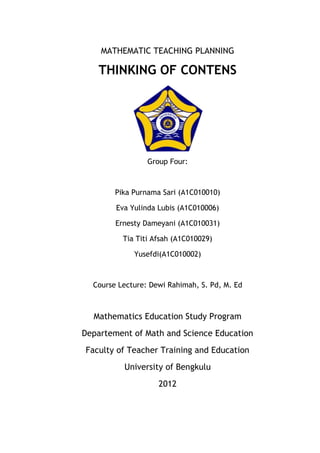
Task 2 PPM - Group 4 - Thinking about Content
- 1. MATHEMATIC TEACHING PLANNING THINKING OF CONTENS Group Four: Pika Purnama Sari (A1C010010) Eva Yulinda Lubis (A1C010006) Ernesty Dameyani (A1C010031) Tia Titi Afsah (A1C010029) Yusefdi(A1C010002) Course Lecture: Dewi Rahimah, S. Pd, M. Ed Mathematics Education Study Program Departement of Math and Science Education Faculty of Teacher Training and Education University of Bengkulu 2012
- 2. THINKING OF CONTENS 1.Please work on this assignment in your group : 1.Please give two examples for each type of knowledge in teaching mathematics a.Declarative Knowledge Facts : 1.two times two equal 4 2.1/5 is a fraction Concepts : 1.Phytagoras is a concept , formula of phytagoras is a2 + b2 = c2 2.Prism is a concept , prismis 3 D shapes.There are rectangular prism , triangular prism and so on. Principles : 1.To count volume,angle, area about cube and so on, rectangular prism.Use the concept about trigonometry and cube concept. 2.Learn about triangle in axis and cout units and angle in triangle. b.Procedural Knowledge 1. Knowing how to using circle props 2.Knowing how to make cube nets 3.Knowing how to prove a phytagoras teorem 2.Please give one example for each way in creating a diversity responsive curriculum in teaching mathematics a.Teach content about diversity Select objectives that focus on developing skills for a diverse world Consider using carrier content related to diversity when teaching any subject matter.
- 3. Example : Using trigonometry’s concept to count and find about angle and how to find a length of object and using in daily activities in different place as like to count widtht of river with trigonometry’s concept. b.Teach content that is complete and inclusive Include all contributors, voices, and perspectives when teaching subjects Emphasize similarities, avoid focusing only on differences To be thorough in your coverage of topics Example : When learn about triangle can use some perspectives from books and use some different tecnique to explain and a lot of detailed of concept and explain material with sistematic ways so student more to understand about materials that we teach. c.Connect the content taught to students’ live Select examples, images, and metaphors connected to students’ experienced and cultural backgrounds Learn about your students’ cultural backgrounds and about the community in which you teach Consider skill diversity Engage students by using content based on their interests Help students learn the skills that will allow them to learn more efficiently. Example : When learn about triangle,rectangular prism, cube, circle and so on ,teacher can make a simple example that can using in daily activity and what they can do with material that they learn, and using materials to increas their a bility and skills for they life.examples: teacher instruction the student to brings object that have shape as like triangle,cube or so on.Then teacher explain about object with simple example and then
- 4. teacher and student learn concept about materials :to find side,area or angle from object so teacher can increas ability cognitif,affective or pshycomoto from student. 3.Please give two examples for each level understanding in teaching mathematics : a.Introductory knowledge example : 1.Teacher can give a general knowledge about triangle to introduction student about triangle and then teacher divide student to small group to discuss with oters student so student can using material to next material and in the end class,teacher give task or exercise to strengththen students’s understanding about triangle. 2.Teacher bring a shape object same like circle to introduction to student and make student more interst to learn.And then teacher give example how to use circle props and student can use knowledge to find concept about circle with experiment. b.Develop a thorough understanding of important knowledge and skills example : 1.Excercise about cube material , so student can understand the material and remember the concept example : how to find area and component in cicle. 2.Find nets of cube and make conclusion for cube material so student can understand about concept’s cube and component of cube. c.Strengthen students’ understanding of previously learned information example : 1.Teacher can provide the concept after taecher and student discusse about rectangular prism and teacher can make example from the concept. 2.Use props cone and cylinder to prove the concept about relation betwen cone and cylinder.
- 5. 4. Please give one example for each analysis in teaching mathematics: a. Subject matter outlines exampe : Materials about prism 3 D shapes.There are rectangular prism ,triangular prism b. Concept analysis example :When learning about prism 3D shape, while the teacher explains that students are instructed to make a list or summary of the material of the sample or not sample prism and the characteristics of the prism that is not found in the other 3D-Shape. c. Principle statement example :After the lesson teacher assigns students to create a table of characteristics,traits,the formulas surface area and volume or table of relational rules that show the relationship between two or more concepts 3D prism so student can use note to memorizing information. d. Task analysis example :Teacher give home work to student about how to find volume from prism 3D and some exercise to strength’s memori of student or question that relition between two or more concepts rectangular prism,triangular prism and so on